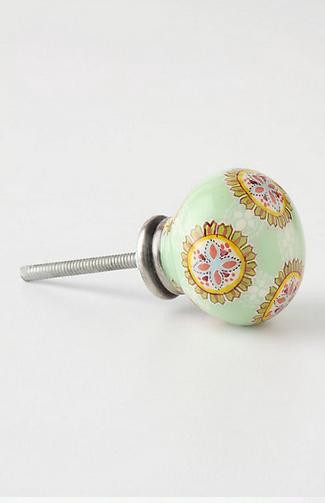Mugs, Gems, and Steals: The Fate(s) of Human Sanity
by Ariel Garfinkel

The SoHo Anthropologie is two blocks from my job running recreational activities at a youth center. The youth center can be hectic and intense, a place where someone is always screeching my name, but Anthropologie is an oasis just beyond this sea of chaos. The building itself is beautiful, painted a soothing putty color with the gentlest inflection of sage, and with angular columns that festoon the double doors. Huge abstract flowers made of individual paper petals the size of your thumb hang in the windows. Each petal has been watercolored for an ombre effect. Just beyond the doors, seven-foot papier-mâché orchids stand among the mannequins. I often come for a brief meditation.
I am sitting on a $3,290 couch, The Winfred Settee in Teal Linen. I came to look at the tea-length dresses printed with polka dots or dachshunds; to inhale the always-burning scented candles — Spring Eden or Capri Blue, or my favorite, Baltic Amber. The space is enormous — all whitewashed pressed-tin ceiling tiles and exposed brick walls, hardwood floors. There is a wall of wooden doors arranged at all angles, a vintage-style bicycle mounted in mid-air balancing an apple crate filled with silk wildflowers, a tumbling line of antique-esque school chairs falling from the ceiling. It is a store of rare finds: $60 tee shirts as soft as an angel’s eyelash, old-fashioned ice cream bowls, hand-painted porcelain teaspoons.
Suddenly, I feel the couch shift. I look to the other end and there sits my boss. Her eyes are closed, her palms reverently pressed together. She is breathing in Capri Blue.
When she opens her eyes, I’m shifting awkwardly. “You come here too?” I ask.
She nods, “When I walk in, I feel a wave of calmness” Her smile is blissful, her brow uncreased. “Because A) No one will find me here. B) It’s so the opposite of where we work — its organized, its beautiful, it smells good. It reminds me there’s another world outside my job, and it’s ok to be part of that world too. I remember there’re people outside of work who don’t even know what it’s like there, and that we can operate in the same space. C) The way everything is so perfectly mismatched makes it seem attainable. And the things are beautiful. And it smells really good.” We sit quietly, sniffing for a few seconds. She continues, “I love that it changes every few weeks, to tickle your creative fancy … the thrill of sifting through the sale rack and finding a particular gem.”
I nod, enthralled. It’s as if I belong to a secret cult, and I’ve only just realized my membership. “What do you do when you get here?” I ask.
“Breathe deeply — and then I go straight to the kitchen section and touch everything. I pick up the mugs; I touch all the knobs.”
The sale section comes next, and she begins with the objects: She does her candle-smelling before moving on to the dish towels — she makes pillows out of them. Clothes next: skirts, then tops. Never pants — they don’t ever fit right. Finds are tried on, scrutinized. Then, she looks at the regularly priced items and fantasizes about what she’ll get when they go on sale. Now comes her favorite part, jewelry — the necklaces, earrings.
“Finally, I check out the stuff at the front, the shit that’s like $400, which I know I’ll never buy. I smile sweetly at the security guard and leave.” She frowns at the thought. “One day I’ll lie on the bed.” She points at the wrought iron frame with its plush patchwork comforter and slurry of decorative pillows.
“Is that allowed?” I ask.
“I doubt it,” she says.
Ariel Garfinkel is a youth worker by day and a writer by other parts of the day (and night). She is pursuing an MFA in nonfiction writing at Columbia.